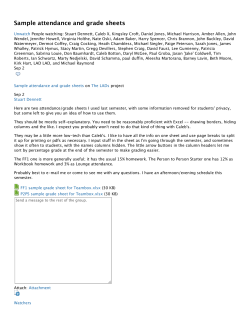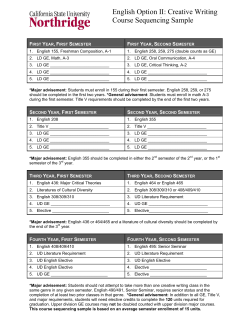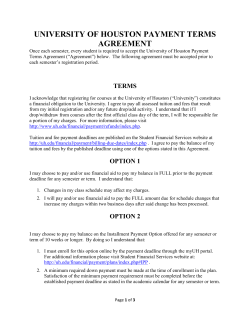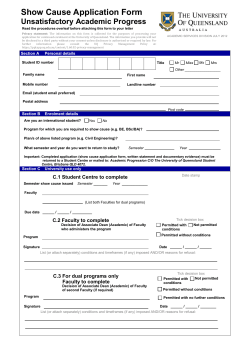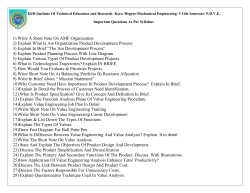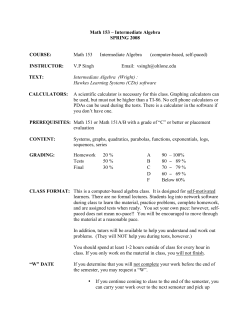
German sample work program Reproduced with the permission of Kenmore SHS German
German Work program sample German sample work program Reproduced with the permission of Kenmore SHS November 2008 A work program is the school’s plan of how the course will be delivered and assessed, based on the school’s interpretation of the syllabus. The school’s work program must meet syllabus requirements, and indicate that there will be sufficient scope and depth of student learning to reflect the general objectives and meet the exit criteria and standards. This sample demonstrates one approach, and should be used as a guide only to help teachers plan and develop school work programs. PLEASE NOTE: This is a sample work program provided by a school. It is not an official publication of the QSA. Queensland Studies Authority Ground floor, 295 Ann Street, Brisbane. PO Box 307, Spring Hill Queensland 4004 Phone: (07) 3864 0299; Fax: (07) 3221 2553; Email: office@qsa.qld.edu.au; Website: www.qsa.qld.edu.au Kenmore State High School SENIOR GERMAN WORK PROGRAM 2008 To be implemented in 2009 COURSE ORGANISATION OVERVIEW: Years 11 and 12 Time Semester 1 Term 1 Theme FAMILY AND COMMUNITY SOCIAL ISSUES Semester 1 Term 2 Semester 2 Term 3 LEISURE, RECREATION AND HUMAN CREATIVITY LEISURE, RECREATION AND HUMAN CREATIVITY SOCIAL ISSUES Semester 2 RECREATION AND HUMAN CREATIVITY Term 4 SOCIAL ISSUES Semester 3 Term 1 LEISURE, RECREATION AND HUMAN CREATIVITY SOCIAL ISSUES Semester 3 Term 2 Semester 4 LEISURE, RECREATION AND HUMAN CREATIVITY SOCIAL ISSUES Term 3 Semester 4 Term 4 SCHOOL AND POST-SCHOOL OPTIONS FAMILY AND COMMUNITY Topic Duration Wer bin ich? 8 weeks Personal descriptions, personality, relationships, home, adolescence, family unit, roles in Australian and German society In-depth Was sind meine Interessen? 8 weeks Jugendkultur in Deutschland und in Australien In-depth Sport, hobbies and interest, radio, television and films; music, art, poetry and short stories. unit Ab nach Deutschland! 8 weeks Holiday planning and itineraries, school exchange, tourist accommodation (hotels, youth hostels and backpackers, campsites), geography (climate, landscapes, city scapes) In-depth Fühle ich mich wohl? 8 weeks Gesundheit, Essen und das seelische Wohlbefinden In-depth unit unit unit Healthy lifestyle, daily routine, diet, exercise, wellbeing, body image, religion and religious tolerance Bier, Wurst und Dirndl – typisch Deutsch? 8 weeks Stereotypes (the typical German / Australian), history, people and events; German literature, music and art. In-depth Das Leben ohne Handy? Unmöglich! 8 weeks Wie bin ich von den Massenmedien beeinflusst? In-depth Old and new media, advertising, internet unit Wie kümmere ich mich um meine Welt? 8 weeks Gewissensfragen In-depth Social issues, ethics: Looking at issues current in Germany and of significance in Australia and comparing them – the environment, drugs in society, abortion, euthanasia unit Wohin jetzt? 5 weeks School, Post-school options and future plans: Looking at pathways in education, issues to do with education and schooling and future directions for students In-depth unit unit The world of work – part-time work and future employment: Looking at individual plans for the future and life goals Coming of age – school formals, graduation, schoolies and getting a driver’s licence NB. The Year 10 German Immersion class completes Year 11 work The Year 11 German Immersion class completes Year 12 work The Mainstream German composite class alternates (Year A/Semester 1 and 2 and Year B/Semester 3 and 4) 3 INTENDED STUDENT LEARNING – UNITS OF WORK SEMESTER ONE TERM ONE – Wer bin ich? Semester 1 Term 1 F&C SI Youth Culture: sports, hobbies, interests, music, art and information technology 8 weeks In-depth unit Learning experiences Language features Language functions Listening and Reading Listening to descriptions of others and guessing who it is. Debate topics "rights", "responsibilities". Reading about film and music, stars. Reading/writing articles on family issues "problems of adolescence", "when and if to marry/have children", "the role of women". Talking about home and house preferences. A revision of basic grammar will be covered during this unit. Identifying and asking about: people things Speaking and Writing "Wer bin ich?" game. "Baby photos". Discussing fashion/clothes. Describing oneself, one's family and friends in person or on the telephone. Giving an oral report about one's family and pets. Writing descriptions of oneself, family and friends. Compare living styles in Germany and Australia. Describing one's room to a penfriend. Writing help letters and responses to a magazine Prepare house plans (own, ideal). Students prepare an indepth analysis of a German speaking friend or celebrity Adjectives* declension attribute (ein schönes Gesicht) predicative (der Mann ist alt) possessive indefinite with fixed prepositions used as nouns positive, comparative, supportive, regular and irregular Articles definite indefinite negative declension Nouns gender number case Verbs tense - present - perfect/conversational past mood - indicative modal verbs* Conjunctions coordinating subordinating Asking about and describing: things physical features (colour, dimensions Asking for and giving: reasons Comparing Enquiring about expressing: opinions preference agreement/disagreement likes/dislikes approval/disapproval Cultural contexts The cultural context will be the world of popular culture and the similarities and differences that are evident between young people in different countries and cultures, and within the same country but in different interest groups. The focus will be on how different young people present themselves through their culture – sport, music, art – and the way they make choices in terms of interests, appearance and language. Word order inversion objects (direct and indirect) expressions of time, manner and place Pronouns possessive Settings (for example) Schools Clubs / youth centres Home Informal meetings Internet Resources: Brennpunkt and Anstoß GCSE textbooks will be the core resources used in this unit. Relevant current affairs topics can be introduced throughout the course. 4 SEMESTER TWO TERM THREE – Ab nach Deutschland! Semester 2 LR&HC Term 3 Travel: Holiday planning and itineraries, school exchange, tourist accommodation (hotels, youth hostels and backpackers, campsites), geography (climate, landscapes, city scapes) Learning experiences Listening and Reading Listening/watching weather forecasts. Compare accommodations. Which is the best? Watch a travelogue. Discuss exchange itinerary and research highlights Read travel brochures. Read about the places to be visited on an /the exchange tour Speaking and Writing Talk about holidays students have been on. Present a slide/photo/video holiday report to the class. Role playing "Reiseburo", "Im Hotel", "Am Campingplatz". Read German weather maps and forecasts. Plan an itinerary for a trip to Germany. Write about a dream holiday. Write a letter to a (pen)friend giving details of travel arrangements. Language features Adjectives demonstrative interrogative Pronouns interrogative relative demonstrative Nouns infinitives used as nouns Prepositions* accusative, dative, accusative/dative formation and use of compounds with da- and woVerbs infinitives with zu infinitives without zu after lassen after modals infinitives used for polite requests modals future Word order and punctuation inverted order - compound and complex sentences Students produce a tour brochure in print or electronic form. Settings (for example) At home, tourist office, accommodation venues, places of interest. 8 weeks In-depth unit Language functions Socialising - Imparting and seeking factual information (a) identifying/asking about things understanding /misunderstanding (b) asking about/describing -places -activities -physical features -experience (c) asking for/giving -time -cost -meaning -clarification -confirmation -reasons - giving instruction -directions (d) reporting Expressing and finding out attitudes (a) enquiring about/expressing -preference -intention -wants and needs -likes/dislikes Getting Things Done (a) asking for/giving -advice -decisions -invitations (b) requesting/offering -help -something to be done -goods and services (c) accepting/declining (d) suggesting (e) negotiating (f) giving commands Cultural contexts The majority of students are preparing for a two month exchange in Term 4 and this topic gives them the opportunity to master essential language for their travels as well as prepare them for the places and conditions they will experience in Germany. Resources: : Brennpunkt and Anstoß GCSE textbooks will be the core resources used in this unit Relevant current affairs topics can be introduced throughout the course. 5 SEMESTER FOUR TERM THREE – Gewissensfragen Semester 4 Term 3 Social Issues Social issues, ethics: Looking at issues current in Germany and of significance in Australia and comparing them – the environment, drugs in society, abortion, euthanasia Learning experiences Language features Listening and Reading Verbs Passive voice actional, statal, impersonal Expressing hypothetical situations with forms of haben, sein, werden, können, mögen listening to and discussing major environmental dangers (Treibhauseffekt, Verschmutzung, Atomenergie) and solutions listening to young people discussing addictions reading articles on environmental problems and possible solutions reading newspaper articles on current events reading re Internet , global communication Expressing concerns and solutions for future roleplaying an addict seeking advice discussing computing advances/Internet preparing promotional material on environment - stickers, posters, brochures, poems writing a protest letter to the editor selecting one major global issue, research and write an article for a school magazine writing a problem page for people with addictions - advice Settings (for example) School Radio station TV studio In-depth unit Language functions 1. Imparting and Seeking Factual Information (a) Identifying/Asking about - things - problems 2. (c) Expressing and Finding Out Attitudes Enquiring about/Expressing - opinions - fears/anger - approval/disapproval Expressing - gratitude - regret - hope Predicting 3. (a) (b) (c) Getting Things Done Warning Suggesting Negotiating (a) (b) Speaking and writing 8weeks Cultural contexts After a broad introduction to a range of significant social issues students focus on one of the following issues: – the environment, drugs in society, abortion, euthanasia. They are asked to produce an educational poster for students highlighting the issue. Resources: Brennpunkt and Anstoß textbooks will be the core resources used in this unit 6 SEMESTER FOUR TERM FOUR – Wohin jetzt? Semester 4 S&PS O Term 4 F&C School, Post-school options and future plans: Looking at pathways in education, issues to do with education and schooling and future directions for students. The world of work – part-time work and future employment: Looking at individual plans for the future and life goals. Coming of age – school formals, graduation, schoolies and getting a driver’s licence Learning experiences Listening and Reading listen to interviews about school/ future plans/ apprenticeship listen to dialogue at Arbeitsamtapplying for work listen to news items about school systems, work trends read in the various media about employment trends. read statistics and articles about trends in education read job advertisements on line read profiles on variety of employment prospects Speaking and writing. discuss one’s own future describe one’s own experiences at school compare German and Qld school systems discuss issues e.g. single sex schools vs co-ed, exam stress write a letter about your own school experiences resume writing write an article for the Kenmore Kurier on your school days. Students present their own school experiences or their future plans. Language features Verbs mood - indicative - subjunctive - conditional common forms to express hypothetical situations (especially forms of sein, haben, werden, können, mögen) pluperfect future Pronouns relative Particles emphatic (doch, mal, schon, eben eigentlich, ja) negative (nichts, noch nicht, doch nicht) Adjectives possessive demonstrative with fixed prepositions participles used as adjectives 5 weeks In-depth unit Language functions Imparting and seeking factual information: expressing and finding out attitudes - opinions - fears - preference - anger - approval / disapproval - agreement & disagreement expressing - regret - hope - praise - blame complaining contradicting getting things done - warning - asking for/giving advice - encouraging - predicting Cultural contexts Settings (for example) Schools Clubs/youth centres Home Informal meetings Internet With guidance officer Students compare and contrast our partner school and Kenmore. They use news broadcasts (das Journal) to compare employment trends in the two countries. Resources: Brennpunkt and Anstoß GCSE textbooks will be the core resources used in this unit Relevant current affairs topics can be introduced throughout the course. 7 Name:____________________ Year: ________ PROFILES – Year 11 MACROSKILLS Date and details of assessment L R S W S1 Term 1 – F&C and SI: Wer bin ich? Conversation about adolescent issues S1 Term 1 – F&C and SI: Wer bin ich? Diary entry or blog about problems with family and / or friends S1 Term 2 – LR&HC: Was sind meine Interessen? Student presentation about an area of interest + teacher questions S1 Term 2 – LR&HC: Was sind meine Interessen? A selection of texts covering sports and hobbies Macroskill Results End of Semester 1 Overall result S2 Term 3 – LR&HC/S&PSO: Ab nach Deutschland! Listening to young Germans describe their holiday experiences S2 Term 3 – LR&HC/S&PSO: Ab nach Deutschland! S-T discussion of the upcoming exchange (or imaginary one) S2 Term 3 – LR&HC/S&PSO: Ab nach Deutschland! Reading a selection of texts related to travel, e.g. brochures, advertisements, travel reviews S2 Term 4 – (for immersion students) Exchange project (describing experiences, diary entries, interviews, research) S2 Term 4 – Fühle ich mich wohl? Writing an article for exchange students on the range of foods available in Australia and recommendations on what to eat and what to avoid. S2 Term 4 – Fühle ich mich wohl? Reading a selection of texts which the topic of well-being. Macroskill Results End of Semester 2 Overall result Macroskills for Monitoring Interim Level of Achievement for monitoring 8 Name: ____________________ Year: ________ PROFILES – Year 12 Date and details of assessment MACROSKILLS L R S W S3 Term 1 - LR&HC/S&PSO: Ab nach Deutschland! S powerpoint presentation on the exchange (or holiday experience) + T questions S3 Term 1 – F&C Typisch Deutsch? Listen to a range of reports about people’s views on what is typically German or typically Australian S3 Term 1 – S&PSO Typisch Deutsch? A selection of texts covering aspects of German culture e.g music, art, history S3 Term 2 – SI and LR&HC Die Medien S-T conversation about the role of media in their lives. Students present part of the Radiosendung from class work. S3 Term 2 – SI and LR&HC Die Medien Articles on the role of the media and its influence and the role advertising plays in society. S3 Term 2 – SI and LR&HC Die Medien S describes how important aspects of the media are in S’s life e.g. Answer the question Ist Fernsehen König? Ist Werbung notwendig? Macroskill Results End of Semester 3 Overall result: S4 Term 3 – SI Gewissensfragen Listening to young people talking about smoking, alcohol and drug use. S4 Term 3 – SI Gewissensfragen S-T roleplay which is the more major problem, legal or illegal drugs or whether euthanasia should be legalised etc S4 Term 3 – SI Gewissensfragen Write a draft for an article for the Engelsburg Kurier on a major social issue Macroskill Results Proposed LoA at Verification: S4 Term 4 – S&PSO F&C Wohin jetzt? Roleplaying a job application and explaining suitability to the position (p/t position using language skills) S4 Term 4 – S&PSO F&C Wohin jetzt? Reading advertisements for jobs and profiles of different people: matching profiles to jobs and justifying decisions Final Macroskill Results Exit Level of Achievement 9 Interim Criteria and Standards – Languages 2009 Listening – standards schema Student work has the following characteristics: Standard A Standard B Standard C Standard D Standard E Knowing and Understanding: Knowing and Understanding: Knowing and Understanding: Knowing and Understanding: Knowing and Understanding: a comprehensive range of information is presented, including gist, main points and relevant details; a range of information is presented, including gist, main points and obvious details; essential information is presented, including some main points and details which may not always be relevant; information is presented, including the meaning of some familiar language; fragmented information is presented; the meaning of familiar and complex language is accurately and clearly demonstrated; the meaning of familiar language is accurately demonstrated but complex language may be misinterpreted; the meaning of familiar language is demonstrated accurately; the speaker’s attitude, purpose and intentions are clearly evident; the speaker’s attitude, purpose and intentions are recognised; the speaker’s general intention is recognised when obvious within a familiar context a very broad outline or some specific details of the speaker’s general intention is demonstrated an isolated understanding of words and phrases is demonstrated subtleties are recognised subtleties may be overlooked Reasoning and Responding: Reasoning and Responding: Reasoning and Responding: Reasoning and Responding: Reasoning and Responding: detailed analysis and thorough evaluation are evident; detailed analysis and evaluation are evident; basic analysis and evaluation are evident; little evidence of basic analysis or evaluation is present; no evidence of analysis or evaluation is presented; plausible interpretations of unfamiliar language are drawn from context; interpretations of unfamiliar language are made from context; well-constructed conclusions and well-substantiated decisions are made; conclusions and decisions are made, although at times justification may be incomplete; conclusions and decisions are made but often lack justification; conclusions and decisions may be made but lack justification; responses are minimal. cultural meanings are integrated into responses where appropriate. cultural meanings are evident in responses but may not be fully developed. obvious cultural meanings are identified. obvious cultural meanings may be identified. 10 Reading – standards schema Student work has the following characteristics: Standard A Standard B Standard C Standard D Standard E Knowing and Understanding: Knowing and Understanding: Knowing and Understanding: Knowing and Understanding: Knowing and Understanding: a comprehensive range of information is presented, including gist, main points and relevant details; a range of information is presented, including gist, main points and obvious details; essential information is presented, including some main points and details which may not always be relevant; information is presented, including the meaning of some familiar language; fragmented information is presented; the meaning of familiar and complex language is accurately and clearly demonstrated; the meaning of familiar language is accurately demonstrated but complex language may be misinterpreted; the meaning of familiar language is demonstrated accurately; the purpose of the text and the writer’s perspective and intention are clearly evident; subtleties are recognised the purpose of the text and the writer’s perspective and intention are recognised; subtleties may be overlooked the writer’s general intention is recognised when obvious within a familiar context a very broad outline or some specific details of the writer’s general intention is demonstrated an isolated understanding of words and phrases is demonstrated Reasoning and Responding: Reasoning and Responding: Reasoning and Responding: Reasoning and Responding: Reasoning and Responding: detailed analysis and thorough evaluation are evident; detailed analysis and evaluation are evident; basic analysis and evaluation are evident; little evidence of basic analysis or evaluation is present; no evidence of analysis or evaluation is presented; plausible interpretations of unfamiliar language are drawn from context; interpretations of unfamiliar language are made from context; well-constructed conclusions and well-substantiated decisions are made; conclusions and decisions are made, although at times justification may be incomplete; conclusions and decisions are made but often lack justification; conclusions and decisions may be made but lack justification; responses are minimal. cultural meanings are integrated into responses where appropriate. cultural meanings are evident in responses but may not be fully developed. obvious cultural meanings are identified. obvious cultural meanings may be identified. 11 Speaking – standards schema – Conveying meaning Student work has the following characteristics: Standard A Knowing and Using Language Features: Knowing and Using Language Features: Knowing and Using Language Features: Standard D Knowing and Using Language Features: a wide range of vocabulary and grammar is used effectively, with few errors; a range of vocabulary and grammar is used effectively, although with some errors; a range of familiar vocabulary and grammar is used, although errors are evident; some familiar vocabulary and grammar is used, although frequent errors are made; a range of cohesive devices is used to express connected thoughts and ideas; Selected cohesive devices are used to connect familiar thoughts and ideas; basic cohesive devices are used to connect simple ideas; some simple linking words are used, but the meaning as a whole is fragmented; register is appropriate to the situation; register is usually appropriate to the situation; pronunciation, intonation, rhythm and stress are acceptable to a background speaker pronunciation, intonation, rhythm and stress are acceptable to a background speaker pronunciation may be affected by first language but is comprehensible by a background speaker pronunciation hinders communication pronunciation hinders communication Creating and Responding: Creating and Responding: Creating and Responding: Creating and Responding: Creating and Responding: ideas, information and meaning are communicated clearly and effectively, although some errors may occur in complex language; ideas, information and meaning are usually communicated clearly, although errors may occur in complex language; where a variety of structures is used, the essential meaning is clear, although there may be frequent errors; there is sufficient accuracy to enable some details to be understood; some simple meanings are conveyed. conversation is initiated and sustained; conversation is generally sustained; spoken communication demonstrates flexibility when using familiar language; spoken communication relies on prompts and cues; spoken communication relies heavily on prompts and cues; responses are relevant to the context, although they may be hesitant; responses are hesitant, repetitive and formulaic but relevant to the context; responses are hesitant, repetitive and rehearsed; some appropriate pause fillers and nonverbal features are used. some nonverbal features are used. some nonverbal features are used. spoken communication demonstrates flexibility, coherence, spontaneity and relevance to the context; appropriate pause fillers and nonverbal features are used where required. Standard B Standard C Standard E Knowing and Using Language Features: responses may be single words or short, well-rehearsed phrases, using familiar vocabulary; 12 Writing – standards schema Student work has the following characteristics: Standard A Standard B Standard C Standard D Knowing and Using Language Features: Standard E Knowing and Using Language Features: responses may be basic sentences using well-rehearsed words and phrases; Knowing and Using Language Features: Knowing and Using Language Features: Knowing and Using Language Features: a wide range of vocabulary and grammar is used effectively; where complex language is used, errors do not detract from the overall meaning; a range of vocabulary and grammar is used effectively, but with some errors; a range of familiar vocabulary and grammar is used, but errors are evident; some familiar vocabulary and grammar is used, but frequent errors are made; a range of cohesive devices is used to link aspects of the text; selected cohesive devices are used to link aspects of the text; basic cohesive devices are used to connect simple ideas; some simple linking words are used, but the meaning as a whole is fragmented; Register is appropriate to the situation; register is usually appropriate to the situation; the register used is generally consistent; spelling, punctuation and word order display a high degree of accuracy spelling, punctuation and word order display a reasonable degree of accuracy spelling, punctuation and word order will contain inaccuracies errors in spelling, punctuation and word order hinder meaning frequent errors are evident Creating and Responding: Creating and Responding: Creating and Responding: Creating and Responding: Creating and Responding: written communication may feature some aspects of the text type; written communication may not always be appropriate to the text type; written communication adheres consistently to the conventions of the text type; the writer’s ideas and purposes are conveyed effectively with flexibility and originality; the writer’s ideas, information and meaning are usually communicated clearly, although errors may occur in complex language; simple ideas are conveyed effectively; some simple ideas are conveyed; written text is wellorganised and displays a high level of coherence; written text is organised and is generally coherent; organisation of the written text is basic and displays some coherence; written text lacks coherence; an understanding and response to cultural contexts is clearly evident in the writing. an understanding and response to cultural contexts may be evident in the writing. the writing shows some recognition of cultural contexts the writing shows little recognition of cultural contexts. some simple meanings are conveyed. 13
© Copyright 2025



